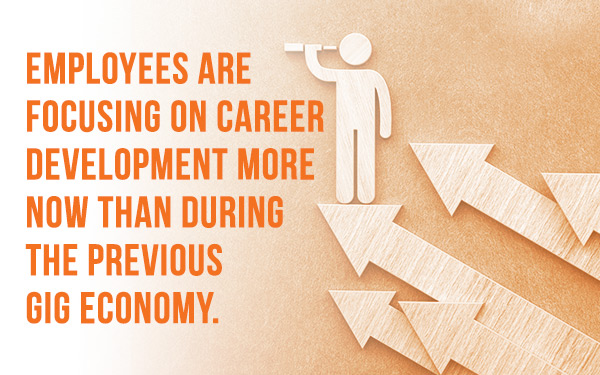How Hiring Has Changed After COVID-19
June 9, 2021
Two years ago, I was writing an article on recruiting and retaining quality employees in a job market that had historically low unemployment of 3.5% in 2019. Fast forward to April 2020, and we have unemployment numbers comparable to the Great Depression. This dynamic poses unique challenges to recruiters and job seekers alike.
The landscape has shifted
Recruiters should be mindful of how COVID-19 has changed the job market in general and understand the unique way your specific industry has been impacted so that you can position roles well for your hiring pool.
Many job seekers are still balancing childcare needs with school closures or hybrid learning models. Remote positions are in demand, while in-person or frontline roles are challenging to fill. Industries like healthcare and delivery logistics are booming, whereas hospitality is struggling. Because of these changes, many individuals are seeking positions in new industries. Recruiters and human resource professionals should consider how existing skills could be adapted for new roles.
Go tech or bust
Recruitment software is a must in today’s hiring environment for everything from sourcing leads to applicant tracking and onboarding. Streamlining this process for you and your potential employee will allow greater productivity in the hiring process. These programs enable you to manage multiple applicants and quickly communicate with potential candidates to secure interviews. When considering your options, be sure to pay attention to the initial implementation cost as well as any annual and reoccurring fees. Selecting a platform that includes downstream functionality such as timekeeping, payroll, and benefits administration is another great way to optimize human capital management resources.
What does it mean to hire with diversity in mind?
Diversity hiring is based on merit, with special care taken to ensure procedures have reduced biases related to a candidate’s age, race, gender, religion, sexual orientation, and other personal characteristics unrelated to their job performance.
Conduct an audit of your current hiring processes to identify strengths and challenges. Ensuring you are sourcing candidates in a way that is accessible to a diverse workforce will also help improve diversity metrics. Using recruitment software can help with this undertaking as well.

Define Success
Any great coach will tell you to define success before deploying new strategies so you can measure and adjust towards your goals. What are your short- and longer-term goals for hiring? What is most important for each role post-COVID-19? Have priorities shifted or duties been reassigned? What does a quality employee look like today?
Don’t forget to consider what success looks like for your potential employees as well. Employees are focusing on career development more now than during the previous gig economy. They want a company that focuses on their career development and overall wellbeing, not just their ability to complete their job. Culture, benefits, and mission are top of mind for millennials looking for new opportunities, and 70% of job seekers want to work for a company that is committed to diversity and inclusion.
Keep in touch
It’s important to maintain contact throughout the hiring process. Yours is likely just one of many roles a candidate is applying for, so it is critical that you stand out from the competition. Start building your brand right away by sharing cultural values, missions, or annual goals and being upfront about compensation and employee benefits. If you are especially proud of your employee retention or glowing employee satisfaction survey, sharing those can be a great resource highlighting why a candidate should choose your company.
Follow up quickly after the initial interview to maintain interest. This will prevent your candidate from losing focus on other opportunities while you move through the hiring process. Frankly, this takes time, but the best candidates will quickly be off the market, so it is a worthwhile endeavor. A gesture as simple as a quick text message including a timeline for the next steps soon after the initial meeting will quickly build a positive relationship.
It’s also beneficial to keep in touch with those who didn’t get the role. You might come across a candidate that would be a great fit for company culture but not the specific position you are looking to fill. It’s perfectly acceptable to keep in touch and build out your talent pool.
If you have questions about recruiting and retaining employees in the post-COVID-19 environment, reach out to Parker, Smith & Feek’s Employee Benefits Department.
Resources and References
- Unemployment rose higher in three months of COVID-19 than it did in two years of the Great Recession, Pew Research Center www.pewresearch.
org/fact-tank/2020/06/11/unemployment-rose-higher-in-three-months-of-covid-19-than-it-did-in-two-years-of-the-great-recession/ - Diversity Hiring: 6 Steps To Hiring More Diverse Candidates, Ideal.com. https://ideal.com/diversity-hiring/
- COVID-19 Shifted Job Seekers’ Priorities. They Want Careers, Not Jobs., Recruiter https://www.recruiter.com/i/how-covid-19-shifted-employee-priorities/
- 3 Things Job Seekers Are Looking For In a New Position, Naviga Recruiting & Executive Search https://www.navigarecruiting.com/3-things-job-seekers-are-looking-for-in-a-new-position/
- 70% of Job Seekers Value a Company’s Commitment to Diversity When Evaluating Potential Employers. PR Newswire. https://www.prnewswire.com/news-releases/70-of-job-seekers-value-a-companys-commitment-to-diversity-when-evaluating-potential-employers-301079330.html
- Text Me Maybe: Keeping In Touch With Candidates During The (Long) Recruitment Process, Greenhouse. https://www.greenhouse.io/blog/text-me-maybe-keeping-in-touch-with-candidates-during-the-long-recruitment-process
- How To Keep In Touch With Great Candidates You Didn’t Hire, Spring Venture Group. https://www.springventuregroup.com/news/keep-touch-great-candidates-didnt-hire/
The views and opinions expressed within are those of the author(s) and do not necessarily reflect the official policy or position of Parker, Smith & Feek. While every effort has been taken in compiling this information to ensure that its contents are totally accurate, neither the publisher nor the author can accept liability for any inaccuracies or changed circumstances of any information herein or for the consequences of any reliance placed upon it.


